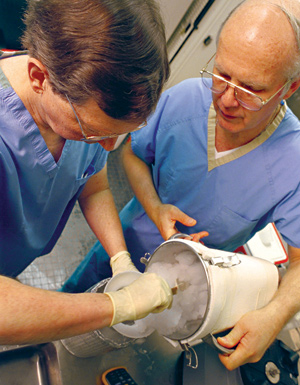|
||
      |
Next Generation
Cold heart, longer life
 To
save heart-attack patients, physicians may soon send them into cardiac
and encephalic hypothermia. Since 1999 Chicago and Argonne National Laboratory
researchers have been developing a saline-suspended ice slurry that, pumped
into the body, would slow down cells’ chemical processes, reducing
organ damage and giving physicians and paramedics more time to administer
therapy.
To
save heart-attack patients, physicians may soon send them into cardiac
and encephalic hypothermia. Since 1999 Chicago and Argonne National Laboratory
researchers have been developing a saline-suspended ice slurry that, pumped
into the body, would slow down cells’ chemical processes, reducing
organ damage and giving physicians and paramedics more time to administer
therapy.
“The trick is to create a partial liquid, partial solid ice slurry that
can flow easily into a patient,” emergency-medicine physician Lance Becker,
who left Chicago for the University of Pennsylvania in June, said at a May
10 American Medical Association media briefing. “If we can introduce
something cold and nontoxic into the lungs of sudden-death victims, then when
you do cardiopulmonary resuscitation, the blood cooled in the lungs is pumped
first to the heart and then into brain.” Hypothermic stasis slows down
brain- and heart-cell death.
Working with perfluorocarbon—a stable, soluble liquid that can deliver oxygen to the lungs—researchers have engineered the ice slurry (pictured with Argonne engineers Ken Kasza, left, and John Oras) to have rounded particles that flow smoothly through small tubes. Early data show that it absorbs eight times more heat than water alone at zero degrees Celsius, keeping the brain cool for an hour.
Sudden cardiac arrest strikes about 1,000 people daily in the United States, with a survival rate of less than 5 percent, Becker said. “With the appropriate therapy, we could save around 50 percent of those people.”
Argonne and U of C researchers believe the mixture also may give physicians more time to perform laparoscopic surgery, which often requires stopping blood flow to small organs. Testing the slurry’s effectiveness in cooling kidneys, Chicago urologist Arieh Shalhav determined that it would reduce the organ’s surface temperature by at least 15 degrees Celsius in only ten minutes.